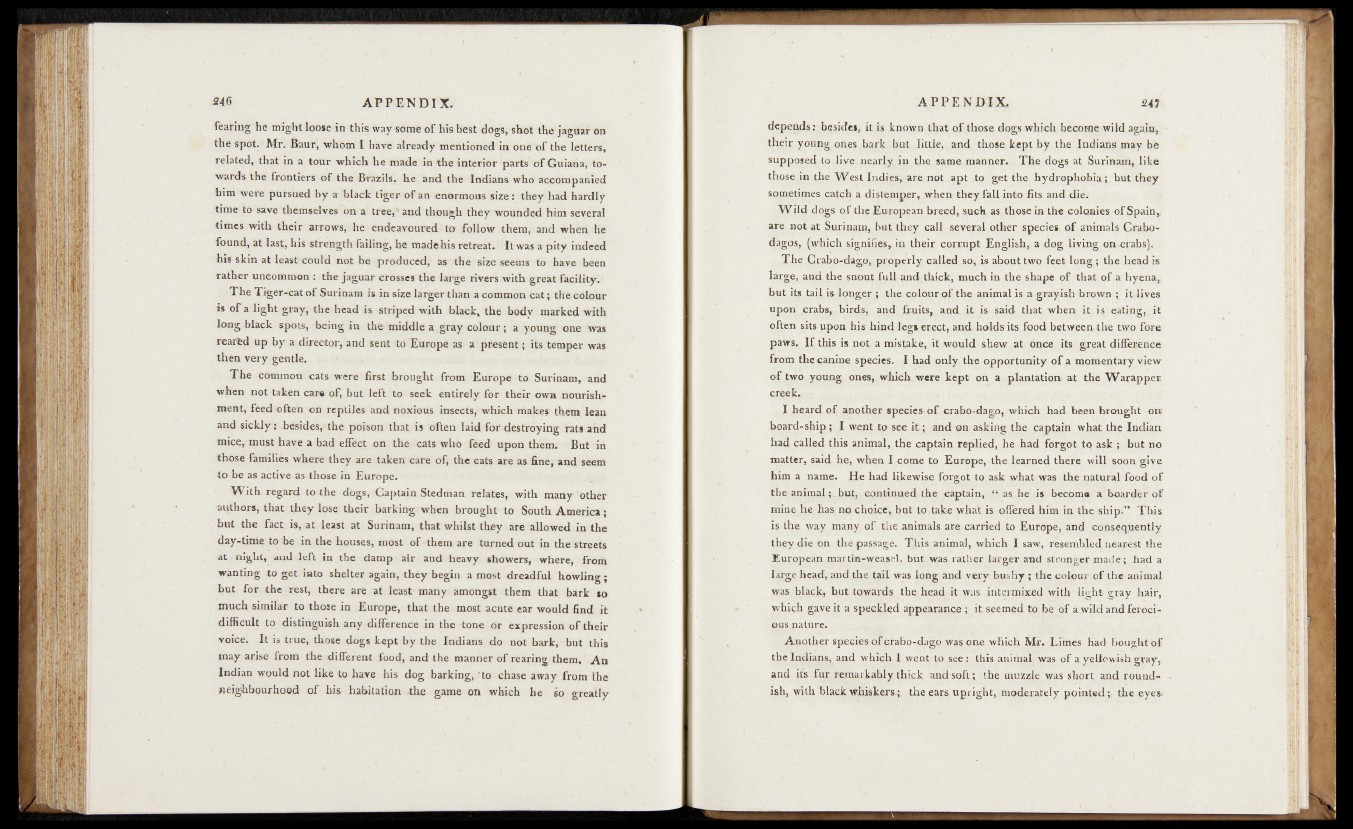
fearing he might loose in this tray some o f his best dogs, shot the jaguar on
the spot. ' Mr. Baur, whom I have already mentioned in one of the letters,
related, that in a tour which he made in the interior parts of Guiana, towards
the frontiers o f the Brazils, he and the Indians who accompanied
him were pursued by a black tiger o f an enormous size: they had hardly
time to save themselves on a tree,'and though they, wounded him several
times with their arrows, he endeavoured to follow them; and when he
found, at last, his strength failing, he made bis retreat. It was a pity indeed
his skin at least* could not be produced, as -the size seems to have been
rather uncommon: the jaguar crosses the large rivers with great facility.
The Tiger-cat of Surinam is in size larger than a common ca t; the colour
is of a light gray, the head is striped with black, the body marked with
long black spots, being in the middle a gray colour; a young one was
reartd up by a director, and sent to'Europe as a present; its temper was
then very gentle.
The common cats Were first brougiit from Europe to Surinam, and
when not taken care of, but left to seek entirely for their own nourishment,
feed often on reptiles and noxious insects, which makes them, lean
and sickly: besides,}the poison that is nften laid for'destroying rats and
mice, must have a bad effect on the cats who feed upon them. But iri
those families where they are taken care of, the cats are as fine, pnd seem
to be as active as those in Europe.
With regard to the dogs, Captain Stedman relates, with many other
authors, that they lose thek barking when brought to South America;
but the fact, is, at least at Surinam, that whilst they are allowed in the
day-time to be in the houses, most of them are turned out in the streets
at night, and left in the damp air and heavy showers, where, frorii
wanting to get into shelter again, they begin a most dreadful howling;
but for the rest, there are at least* many amongst them that bark so
much similar to those in Europe, that the most acute ear would find it
difficult to distinguish any difference in the tone or expression of their
voice. It is true, those dogs kept by the Indians do not bark, but this
may arise from the different food, and the manner of rearing them. An
Indian would not like to have his dog barking, 'to chase away from the
neighbourhood of his habitation the game on which he so greatly
depepds r besides, it is known that of those; dogs which become wild again,,
their young ones b^rk but little, and these kept by the Indians may be
supposed to live nearly ip, the same manner.*. The dogs at Surinam, like
those, in.the West Indies, are not apt to get the hydrophobia ; but they
sometimes catch a distemper, when they fall into fits and die.
Wild dogs of the European breed, such as those in the colonies of Spain,,
are not at Surinam, E>ut they call several other species of aoimals Crabo-
dagos, (which signifies, in their corrupt English, a dog living on-crabs)..
; The Crabo-dago, properly called so, is about two feet long ; the head is
large, and the snout full and thick, much in the shape of that of a hyena,,
but its tail is longer ; the colour of the animal is a grayish brown ; it .lives
upon crabs, birds, and fruits, and it is said that when it. i$ eating, it
often sits upon his hind legs erect, and holds its food between- the two fore
paws. If this is not a mistake, it would shew at once its great difference
from the canine species. I had only the opportunity of a momentary view
of two young-ones, which were kept on a plantation at the Warapper
creek. ■
I heard of another species-of crabo-dago,.-which had been brought o s
board-ship; I went to see it; and on asking the captain what the Indian
had called this animal, the captain replied,|B had forgot tq ask ; but no
matter, said he, when I come to Europe, the learned there will soon give
him a name. He had likewise forgot to ask what was the natural food o f
the animal; but, continued (he captain, “¥as he is become- a boarder of
mine he has no choice, but to take what i s offered him in the ship.” This
is the way many, of the animals are carried to Europe, and consequently
they die on the passage. This animal, which 1 saw, resembled nearest the
European martin-wegsel, but was rather larger and stranger had a
large head', and the tail was long and very- bushy ; the colour of -the animal
was black, but towards the head it was intermixed with light gray hair,
which gave it a speckled appearance it seemed to be of a wild and ferocious
nature.
Another species o f crabo-dago Was one which Mr. Limes had bought o f
the Indians, and which I wept to see: this animal was of a yellowish gray,
and its fur remarkably thick and soft; the muzzle was short, and roundish,
with black whiskers-;, the ears- upright, moderately pointed; the eye*»